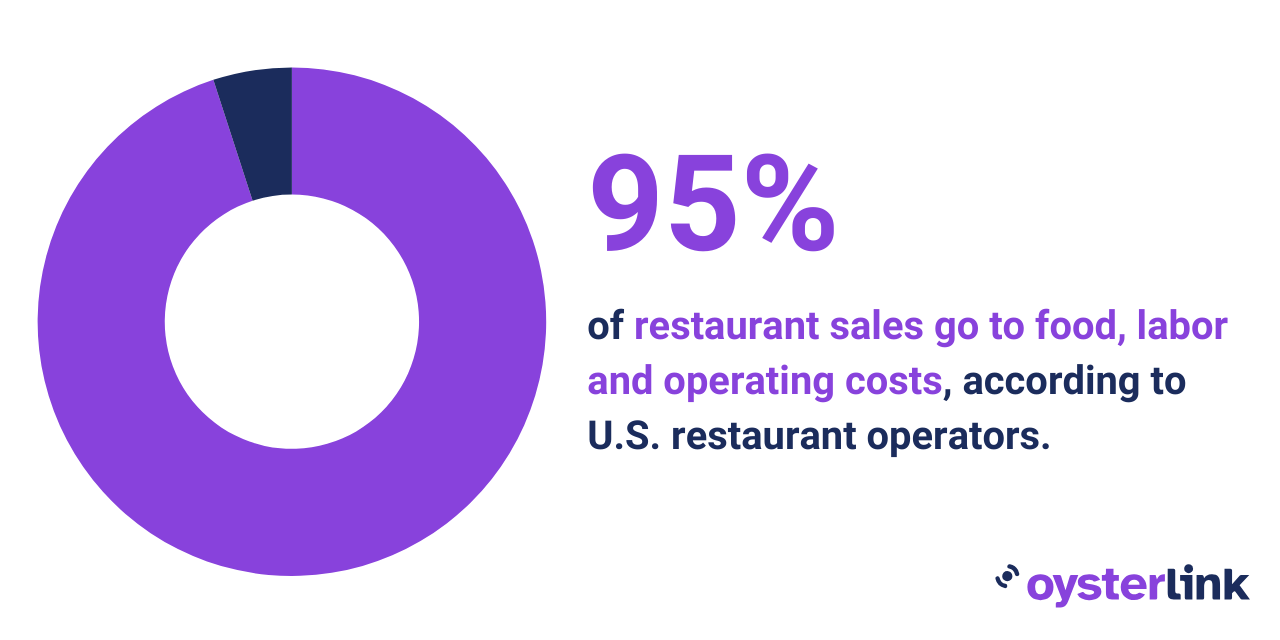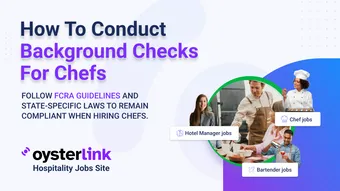Restaurant Operations: 3 Key Takeaways
- 85% of restaurant operators say they’re less profitable now than in 2019.
- Restaurants that invest in employee training see 75% lower turnover.
- Digital tools like POS systems and automated scheduling reduce labor costs.
Restaurant operations can make or break your business.
This guide reveals proven strategies top operators use to turn daily chaos into consistent profit - and how you can do the same.
Why Improving Restaurant Operations Is Essential for Success
The answer is simple: for operational efficiency, which means running your restaurant business smoothly and smartly.
It's about getting the most out of your resources — people, time and money — while giving customers great food and service.
When a restaurant runs like a well-oiled machine, tasks are completed quickly, accurately and with minimal waste or unnecessary costs.
This translates to shorter wait times for customers, working with a happier staff and seeing your revenue increase.
Top Challenges in Managing Efficient Restaurant Operations
Running a successful restaurant operation is filled with challenges.
There are many obstacles to overcome just to keep it operating and making it profitable, including:
- Finding and retaining qualified staff amid labor shortages and high employee turnover
- Balancing profitability with customer expectations amid rising food and labor costs
- Controlling food waste, maintaining optimal stock levels and dealing with supply chain disruptions
- Adapting to changing economic conditions and consumer spending habits
- Standing out in a crowded market and constantly attracting new customers
- Implementing and utilizing technology effectively without disrupting operations
- Properly complying with health and food safety standards while maintaining efficiency
How to Improve Restaurant Operations with Smart Strategies
A good example is the use of a restaurant point-of-sale system, which automates order taking, payment processing and inventory management.
Instead of manually calculating bills and managing stock, your staff can focus on customer service and other critical tasks.
Achieving both efficiency and profitability is the key to the longevity of your restaurant business.
Below are our tips on how to improve restaurant operations, along with practical strategies and examples, to help you optimize your restaurant's performance.
Create Strict SOPs
Strict standard operating procedures (SOPs) in a restaurant are detailed guidelines that outline the exact steps for every task.
These guidelines are there to ensure consistency and efficiency within the operation and serve as a blueprint for employees to minimize errors.
For example, an SOP for food handling might specify exact temperatures for refrigeration and cooking times for different ingredients.
It would also include proper cleaning procedures for the kitchen equipment used to ensure food safety and prevent contamination.
Another example is an SOP for customer service, which outlines in detail how the staff should greet customers, handle complaints and process payments.
Implementing strict SOPs is the first step to improving restaurant operations and providing a solid foundation for training the employees.
Streamline and Automate Processes
“Streamlining and automating” may sound technical, but it only means simplifying the tasks.

Your team will benefit from these initiatives through timesaving and minimized errors.
Implementing technology such as Point of Sale (POS) systems, kitchen display systems (KDS), and inventory management software can also significantly enhance efficiency.
For example, a POS system can expedite order processing and provide real-time sales data, while an inventory management system helps track stock levels.
Automating staff scheduling through specialized software ensures optimal coverage during peak hours and reduces labor costs.
Implement Technology
In today's digital age, leveraging technology is crucial for optimizing restaurant operations.
Consider using:
- Online reservation platforms
- Employee scheduling software
- Customer Relationship Management (CRM) tools
Improve Your Menu
Optimize your menu by selecting or creating dishes that not only appeal to customers but also maximize your restaurant's profitability.
Work with your Chef to have a balance of popular items and high-margin dishes, therefore providing more options.
For instance, a popular burger might be a crowd-pleaser, but it gives you lower profit margins due to the costs of ingredients.
So, why not consider offering a gourmet burger with higher-priced toppings as an alternative?
This way, you're increasing its average order value minus raising the costs to prepare it.
Finding that balance in your menu is more important than ever.
In fact, the National Restaurant Association (NRA) reported that soaring costs are limiting restaurant operations.

[Source: National Restaurant Association]
In a survey conducted by the NRA, 85% of restaurant operators say they’re less profitable now than in 2019, as 95% of their sales go to food, labor and operating costs.
However, they’re also careful about increasing prices that may turn off many customers, and this hesitation results in some profit losses.
Analyzing sales data will help address this challenge.
Identify your best-selling items and consider highlighting them to encourage more orders.
Meanwhile, low-selling and low-profit items might need to be removed or revamped.
Strengthen Employee Relations
Make your restaurant a great place to work by fostering a supportive and positive work environment where employees feel valued, respected and engaged.
Restaurant Managers or the Director of Operations can create a shared sense of purpose by building trust and communicating with their staff.
These employees, in turn, will do their best to ensure your operational efficiency.
Effective employee relations encompass various aspects such as:
- Providing fair compensation and benefits
- Setting clear expectations and performance feedback
- Providing opportunities for advancement
- Focusing on work-life balance
As your staff works hard every day to ensure smooth restaurant operations, for your part, make sure to prioritize their well-being and professional growth.
Implement significant staff-focused changes and see how your turnover rate improves.
Enhance Employee Training
- Regular training programs: Conduct ongoing training sessions to keep staff updated.
- Career advancement opportunities: Provide clear pathways for promotion to motivate them.
- Employee recognition: Implement reward systems to acknowledge outstanding performance.
Reduce Operational Costs
Implementing cost-effective measures without compromising quality is a delicate balance that requires careful planning and execution.
One effective example is to optimize your supply chain.
You can consolidate orders with fewer (but reliable) suppliers so you can negotiate better prices and reduce delivery costs.
This initiative can lead to significant savings without sacrificing your menu's quality.
Another crucial area you can focus on is inventory management.
Implementing an efficient inventory system will prevent overstocking and reduce food waste, which both come with associated costs.
Running a cost-efficient restaurant means knowing your operations well enough to spot and eliminate waste that drives up expenses.
Use Data Analytics To Gain Customer Insights
We're lucky to live in a time where we can harness customer data to understand their buying behavior and preferences.
This is also true in the restaurant industry.
There are several tools you can use to collect customer data, the most popular of them include:
- Point-of-sale (POS) system
- Customer relationship management (CRM) software
- Online ordering and reservation platforms
- Sales data to identify best-selling items and underperforming dishes
- Reviews and feedback forms to pinpoint areas needing improvement
- Inventory patterns to prevent overstocking or stockouts
Through these tools, your restaurant can gain valuable insights into your customer demographics, spending habits and order preferences.
Analyzing data from loyalty programs, online reservations, and customer feedback forms can reveal patterns in dining habits and preferences.
For instance, if data indicates a high demand for vegetarian options, consider expanding your plant-based menu offerings.
Strengthen Marketing and Promotions
In today's digital age, a robust online presence is crucial for attracting and retaining customers.
Ensure your restaurant's website is user-friendly, mobile-optimized, and provides essential information.
Also, engage with customers on social media platforms by sharing updates, promotions, and behind-the-scenes content.
Utilize email marketing campaigns to inform patrons about special events and offers.
Encourage satisfied customers to leave positive reviews on platforms like Yelp and Google to enhance your restaurant's reputation.
In addition:
- Post regularly on platforms like Instagram, TikTok, and Facebook
- Partner with local influencers, host live music nights, or collaborate with nearby businesses
- Launch a points-based or membership rewards program
- Capitalize on holidays and local events by offering limited-time menus or discounts.
Follow Health and Safety Standards
A single case of food poisoning can destroy your restaurant’s reputation.
This emphasizes the importance of following health and safety standards.
Complying with regulations is crucial in effective restaurant operations to maintain a clean and safe environment.
If you haven't taken this seriously yet, now's the time to implement thorough cleaning and sanitation procedures throughout the restaurant.
This includes regular disinfection of surfaces, equipment and utensils to prevent the spread of germs.
You should also enforce proper food safety training for all employees to make sure they understand the importance of personal hygiene and food handling practices.
Develop Sustainability Practices
Adopting sustainable practices not only benefits the environment but also appeals to the growing number of eco-conscious consumers.
- Implement portion control, repurpose surplus ingredients, and donate excess food to minimize waste
- Invest in energy-saving appliances to reduce utility costs
- Use biodegradable or reusable packaging materials to decrease plastic waste
- Partner with local farmers and suppliers to obtain fresh, sustainable ingredients.
Conduct Regular SWOT Analyses
Performing regular SWOT analyses helps identify internal and external factors affecting your restaurant's performance.
For example, strong customer loyalty could inspire a referral program, while weak staff training may call for improved training protocols.
5 Steps to Analyze and Improve Your Restaurant Operations
Follow these tips so you can gain valuable insights into your restaurant's strengths and weaknesses:
1. Conduct a comprehensive assessment
A thorough assessment of your restaurant's operations will identify areas for improvement.
Evaluate all aspects of your business, from front-of-house service to back-of-house operations.
Analyze your current systems, procedures and staffing levels to identify any inefficiencies that need fixing.
2. Identify bottlenecks in the processes
Bottlenecks are points in your operations that slow down the process or create delays.
These could be in the kitchen, at the point of sale or in customer service.
Removing these bottlenecks will streamline your restaurant operations and improve its overall efficiency.
3. Seek customer feedback
Your customers are your most valuable source of information.
Gather feedback through surveys, online reviews and direct customer interactions.
Knowing their perceptions of your restaurant's service, food quality, and atmosphere will help you identify areas for improvement.
4. Assess your financial performance
Identify areas where you can reduce costs or increase revenue.
Track key performance indicators (KPIs) such as sales, labor costs and food costs to identify trends and areas for improvement.
5. Get your employees’ feedback
Your employees have a unique perspective on your restaurant's operations.
Conducting employee surveys or holding open forums will help you gather their input on any challenges and suggestions for improvement.
Empower your employees to share their ideas to find innovative solutions and increase their job satisfaction.

Conclusion: Mastering Restaurant Operations for Long-Term Growth
The road to improving restaurant operations is paved with challenges, but it’s not impossible to achieve.
Some processes will be easy, while some a bit more difficult to do.
However, with strategic planning and your relentless pursuit of excellence, you can make significant improvements to truly achieve successful restaurant operations.











Loading comments...